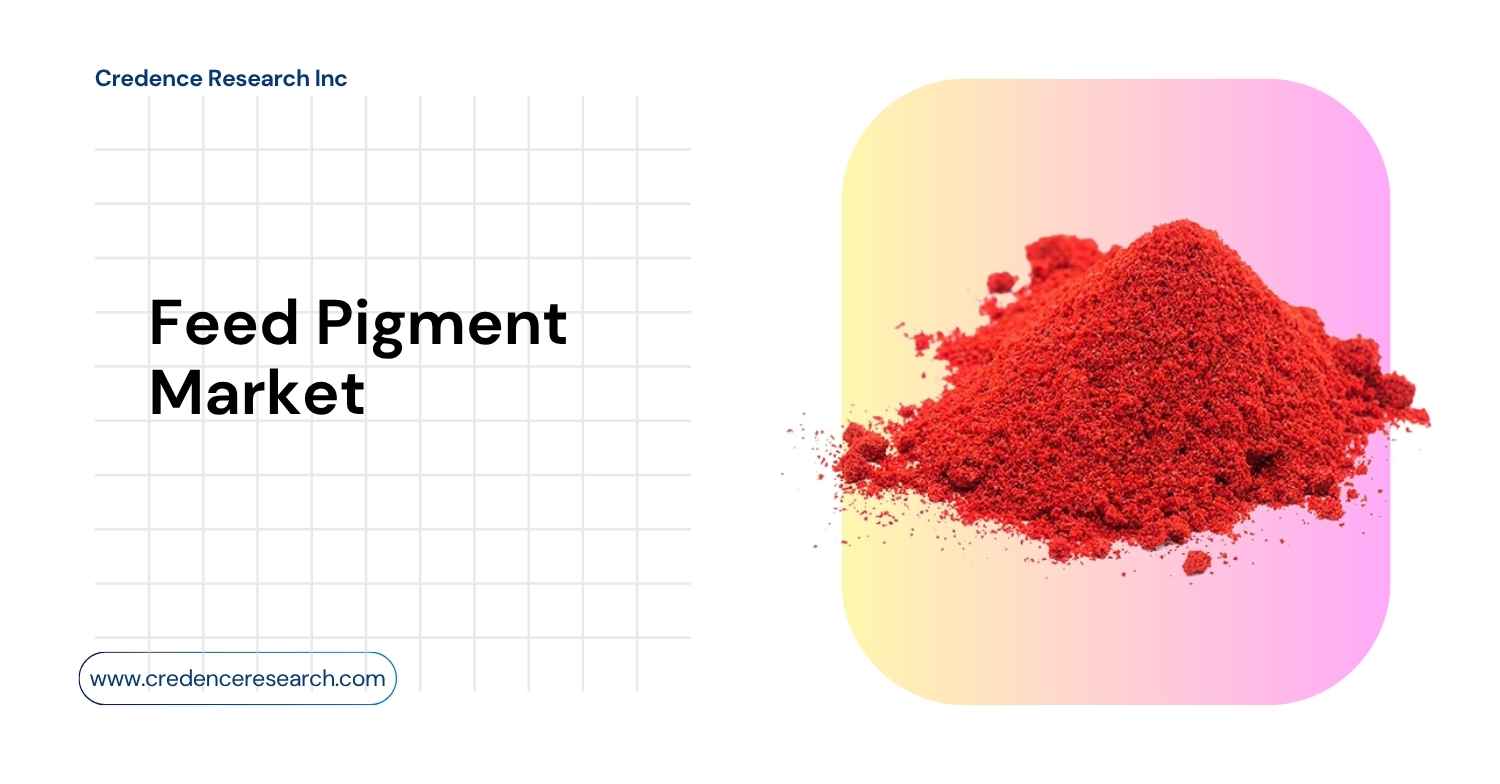According to Credence Research’s latest report titled “Global Feed Pigment Market – Growth, Share, Opportunities & Competitive Analysis, 2024–2032.”, the global feed pigment market is projected to expand from USD 1,389.66 million in 2024 to USD 2,257.04 million by 2032, registering a compound annual growth rate (CAGR) of 6.25% over the forecast period.
Feed pigments are color-enhancing additives used in animal nutrition to improve the visual appeal of products such as egg yolks, broiler skin, and fish flesh. These pigments are primarily used in poultry, aquaculture, swine, and ruminant feed to influence color outcomes and support animal health. The market’s expansion is driven by increasing demand for visually appealing animal products and rising awareness of the nutritional benefits associated with natural pigments.
Feed pigment formulations are available in both natural and synthetic forms. Natural pigments, derived from sources such as algae, turmeric, and marigold, are gaining popularity due to consumer preferences and regulatory shifts. Synthetic pigments remain in use due to their consistent coloring properties and cost-effectiveness. The choice between natural and synthetic variants is influenced by regional regulations, cost margins, and end-user requirements.
Increasing Demand for Color-Enhanced Animal Products Across Poultry and Aquaculture
A major driver for the global feed pigment market is the growing consumer demand for color‑enhanced animal products, reflected in regulatory frameworks that specify allowable pigment use levels in feed, such as the U.S. limit for astaxanthin in salmonid diets at 80 mg/kg and mandatory labeling of its use on fish feed and fish products.
In poultry, consumer studies report preferred yolk color fan values clustered around 5–8 and 16 on standardized scales, evidencing clear market expectations for deeper pigmentation in many regions. In aquaculture, global output reached 130.9 million tonnes in 2022 and major producer lists include China, Indonesia, India, Vietnam, and Chile, underscoring the scale at which salmon and trout flesh coloration directly influences acceptance and value in key markets.
Producers are using feed pigments to meet these expectations while maintaining product differentiation, and regulatory science supports their efficacy and safe use; EFSA deems synthetic astaxanthin safe for salmonids up to 100 mg/kg complete feed and efficacious in coloring salmonid flesh, while canthaxanthin is efficacious in egg yolk and poultry skin/fat pigmentation with defined safe use levels by bird class. These pigments not only improve appearance but may also confer antioxidant support: peer‑reviewed reviews document astaxanthin’s strong free‑radical scavenging capacity and enhancements to antioxidant status in fish and poultry, including improved enzyme activities and reduced lipid peroxidation in controlled studies.
The poultry sector remains the largest consumer of feed pigments due to consistent global demand and widespread preference for pigmented eggs and skin, as reflected in EFSA’s canthaxanthin evaluations for laying hens at 8 mg/kg and for chickens for fattening at 25 mg/kg, together with evidence of consumer preference for deeper yolk coloration in multiple markets.
Aquaculture follows, driven by expansion in farmed salmon and shrimp production; for instance, Chile’s farmed salmon and trout output in 2022 totaled 1,065,398 tonnes, illustrating the scale at which controlled flesh pigmentation is commercially relevant. As fish farming increases in Asia Pacific and Latin America, demand for high‑quality pigmentation continues to grow, with FAO reporting aquaculture at 130.9 million tonnes in 2022 and identifying top producing countries across these regions, including China, Indonesia, Vietnam, and Chile.
Feed manufacturers are responding with pigment systems and additive forms assessed by regulators for safety and efficacy—such as EFSA opinions on branded canthaxanthin and multiple astaxanthin formulations—optimizing performance, stability, and cost across species and production environments.
Browse market data figures spread through 220+ pages and an in-depth TOC on “Feed Pigment Market”
Shift Toward Natural Pigments Driven by Consumer and Regulatory Pressures
An emerging trend in the feed pigment market is the transition from synthetic pigments to naturally derived alternatives. Regulatory authorities and consumers are pushing for cleaner, more transparent food systems. This has led to increased demand for feed additives made from natural sources, such as marigold flowers, red pepper, algae, and turmeric.
Spirulina, a natural blue-green algae, and curcumin, extracted from turmeric, are gaining popularity due to their strong pigmenting properties and functional health benefits. These natural ingredients are being increasingly integrated into feed formulations to provide dual functionality—color enhancement and immune support. Producers are investing in extraction and stabilization technologies to improve pigment intensity, shelf life, and bioavailability of natural ingredients.
In Europe, stricter rules on synthetic additives have accelerated this trend. Meanwhile, consumers in North America and Asia are showing growing preference for poultry and seafood products labeled as “naturally raised” or “free from synthetic additives.” Feed manufacturers are now prioritizing clean-label solutions, especially in premium livestock and aquaculture segments.
This trend is expected to continue as more food processors and retailers adopt clean-label policies. The global movement toward sustainability is reinforcing this shift, encouraging investment in plant-based pigment sources that reduce environmental and regulatory risks.
High Cost and Limited Stability of Natural Pigments Impact Adoption
Despite increasing demand, the adoption of natural feed pigments remains limited by their high cost and variable performance. Natural pigments often require extensive processing, purification, and stabilization, which raises production costs compared to synthetic variants. Their pigmenting power can also be inconsistent due to seasonal variations and source quality, making it harder for producers to achieve consistent end-product coloration.
Additionally, many natural pigments are sensitive to heat, light, and pH fluctuations, which affect their stability during feed production and storage. This presents technical challenges for feed formulators aiming to maintain pigment potency across supply chains. Shelf life and feed integration are also critical issues, especially in tropical regions where storage conditions can accelerate degradation.
Feed manufacturers must invest in encapsulation and delivery technologies to protect natural pigments during pelleting and extrusion. These added processing steps further increase product cost and complexity. For cost-sensitive livestock operations, the price premium on natural pigments often outweighs perceived benefits, resulting in continued reliance on synthetic alternatives.
As natural pigment use grows, addressing these stability and cost issues will be essential to support broader market penetration. Innovations in pigment extraction, processing, and formulation are expected to play a key role in overcoming this challenge.
Market Segmentation
By Type
- Carotenoids
- Curcumin
- Spirulina
- Others
By Source
- Naturally
- Synthetically
By Livestock
- Poultry
- Swine
- Ruminants
- Aquaculture
- Others
By Application
- Aquaculture
- Poultry
- Swine
- Ruminant
By Region
North America
- US
- Canada
- Mexico
Europe
- Germany
- France
- UK
- Italy
- Spain
- Rest of Europe
Asia Pacific
- China
- Japan
- India
- South Korea
- South-east Asia
- Rest of Asia Pacific
Latin America
- Brazil
- Argentina
- Rest of Latin America
Middle East & Africa
- GCC Countries
- South Africa
- Rest of Middle East and Africa
Key Player Analysis
Major players in the feed pigment market are investing in new pigment technologies, regional expansion, and natural pigment development. Several companies are strengthening their production capabilities and distribution networks to meet growing demand from poultry and aquaculture segments. Partnerships with feed manufacturers and research institutions are also supporting innovation in pigment extraction and feed delivery systems.
Key market players:
- BASF SE
- Biorigin
- Behn Meyer Group
- Hansen Holding A/S
- D. Williamson & Co. Inc. (DDW)
- Guangzhou Leader Bio-Technology Co. Ltd.
- Kemin Industries Inc.
- Kalsec Inc.
- Royal DSM N.V.
- Nutrex NV
- Novus International, Inc.
- Phytobiotics Futterzusatzstoffe GmbH
- Synthite Industries Ltd
These companies are focusing on product stability, pigment concentration, and expanded sourcing of botanicals. Strategic acquisitions and R&D investments are supporting long-term growth strategies and enhancing global competitiveness. The focus on natural, sustainable, and functional pigments is expected to shape product development in the coming years.
About Us:
Credence Research is a viable intelligence and market research platform that provides quantitative B2B research to more than 2000 clients worldwide and is built on the Give principle. The company is a market research and consulting firm serving governments, non-legislative associations, non-profit organizations, and various organizations worldwide. We help our clients improve their execution in a lasting way and understand their most imperative objectives.
Contact Us
Credence Research Europe LTD
128 City Road, London,
EC1V 2NX, UNITED KINGDOM
Europe – +44 7809 866 263
North America – +1 304 308 1216
Australia – +61 4192 46279
Asia Pacific – +81 5050 50 9250
+64 22 017 0275
India – +91 6232 49 3207











